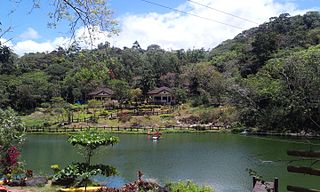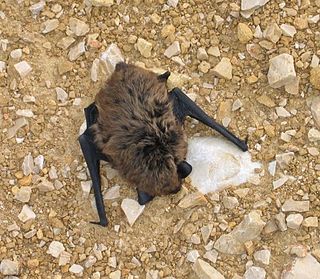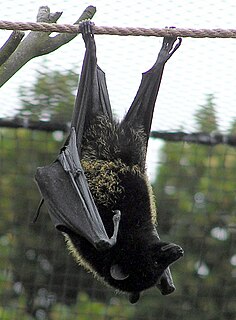
The Philippine naked-backed fruit bat or Philippine bare-backed fruit bat is a megabat that mostly lives on Negros Island. Two small populations were also found on Cebu Island in the Philippines. Like other bare-backed fruit bats, its wings meet along the midline of their bodies, making it a very agile flier. It roosted in caves, in areas where little light penetrated the gloom. It was so abundant once that it left piles of guano, which were used by miners as fertiliser.

Murcia, officially the Municipality of Murcia, is a 1st class municipality in the province of Negros Occidental, Philippines. According to the 2015 census, it has a population of 81,286 people.

The greater horseshoe bat is a bat of the genus Rhinolophus. Its distribution covers Europe, Northern Africa, Central Asia and Eastern Asia. It is the largest of the horseshoe bats in Europe and is thus easily distinguished from other species. The species is sedentary, typically travelling up to 30 kilometres (19 mi) between the winter and summer roosts, with the longest recorded movement being 180 km (110 mi). The species is notable as having the oldest recorded age for any European bat, with a bat living for over 30 years. The frequencies used by this bat species for echolocation lie between 69–83 kHz, have most energy at 81 kHz and have an average duration of 37.4 ms.

The Convention on the Conservation of Migratory Species of Wild Animals -- more commonly abbreviated to just the Convention on Migratory Species (CMS) or the Bonn Convention and CMS COP is known as Global Wildlife conference—aims to conserve terrestrial, marine and avian migratory species throughout their range. It is an international treaty, concluded under the aegis of the United Nations Environment Programme, concerned with the conservation of wildlife and habitats on a global scale. Since the Convention's entry into force, its membership has grown steadily to include over 120 Parties from Africa, Central and South America, Asia, Europe and Oceania. The Convention was signed in 1979 in Bad Godesberg, a suburb of Bonn, and entered into force in 1983. The depositary is the government of the Federal Republic of Germany.

The northern bat is the most abundant species of bat in northern Eurasia. It is found from England to Hokkaidō and down to northern India. It is closely related to Serotine bat.

Savi's pipistrelle is a species of vesper bat found across North West Africa, the Mediterranean region and the Middle East. It feeds at night on flying insects. In the summer it roosts under bark, in holes in trees, in old buildings and in rock crevices but in winter it prefers roosts where the temperature is more even such as caves, underground vaults and deep rock cracks.

Livingstone's fruit bat, also called the Comoro flying fox, is a megabat in the genus Pteropus. It is an Old World fruit bat found only in the Anjouan and Mohéli islands in the Union of the Comoros in the western Indian Ocean.

Bechstein's bat is a species of vesper bat found in Europe and western Asia, living in extensive areas of woodland.

The Rodrigues flying fox or Rodrigues fruit bat is a species of bat in the family Pteropodidae, the flying foxes or fruit bats. It is endemic to Rodrigues, an island in the Indian Ocean belonging to Mauritius. Its natural habitat is tropical lowland forests. The bats are sociable, roost in large groups during the day and feed at night, squeezing the juice and flesh out of fruits. They are hunted by humans for food and their numbers have been dwindling, and the International Union for Conservation of Nature has rated the species as being "endangered". In an effort to preserve them from extinction, some bats have been caught and are being bred in various zoos around the world.
The Agreement on the Conservation of Populations of European Bats is an international treaty that binds the Parties on the conservation of bats in their territories. It was set up in 1991 under the auspices of the Convention on Migratory Species of Wild Animals (CMS), also known as "Bonn Convention". In July 2018, the Agreement covers 36 of 63 range states.

Scotophilus is a genus of vespertilionid bats commonly called yellow bats. They are found in southern Asia and Africa.
The Bat Conservation Trust (BCT) is a registered British charity dedicated to the conservation of bats and their habitats in the UK. BCT was founded in 1991 and is the only national organisation solely devoted to bats. Its vision is a world where bats and people live in harmony. BCT currently has a membership of around 5,600, including individuals, families, teachers and youth workers and corporate businesses.
The Great Lakes Bat Festival is an annual two-day summer event that started in 2002.1 It has been held at the Cranbrook Institute of Science Bat Zone in Bloomfield Hills, Michigan2, at the Indiana State University Center for North American Bat Research and Conservation in Terre Haute, Indiana3, at the Milwaukee County Zoo in Milwaukee, Wisconsin, and in Iron Mountain, Michigan near Millie Hill Mine4.

Organization for Bat Conservation (OBC) was a national environmental education nonprofit based in Bloomfield Hills, Michigan established to educate and inspire people to save bats. In February 2018, it was announced that the Organization was ceasing operations due to unexpected financial problems and personnel changes.

The Alcathoe bat is a European bat in the genus Myotis. Known only from Greece and Hungary when it was first described in 2001, its known distribution has since expanded to Spain, England, Sweden, and Azerbaijan, among other countries. It is similar to the whiskered bat and other species and is difficult to distinguish from them. However, its brown fur is distinctive and it is clearly different in characters of its karyotype and DNA sequences. Although some genetic data suggest that it is related to Geoffroy's bat, other analyses do not support a close relationship between M. alcathoe and any other species.

Escalera's bat is a European bat in the genus Myotis, found in Spain, Portugal, and far southern France.

The greater monkey-faced bat, is a megabat endemic to Solomon Islands, Bougainville, in Papua New Guinea, and nearby small islands. It is listed as a critically endangered species and the population is decreasing. It is the largest monkey-faced bat.
The Armenian whiskered bat, also known as the Hajastan myotis or the Armenian myotis, is a species of bat from the family Vespertilionidae. The Armenian whiskered bat was formerly included as a part of the whiskered bat, but was considered distinct in 2000 as a result of morphologic comparison.

The Devon Bat Group (DBG) was founded in 1984 to help protect bats and their habitats, to look after injured bats and to advise and educate people about bats.

Kolombatovic's long-eared bat, also known as the Mediterranean long-eared bat, is a European species of bat found in the Balkans.

















